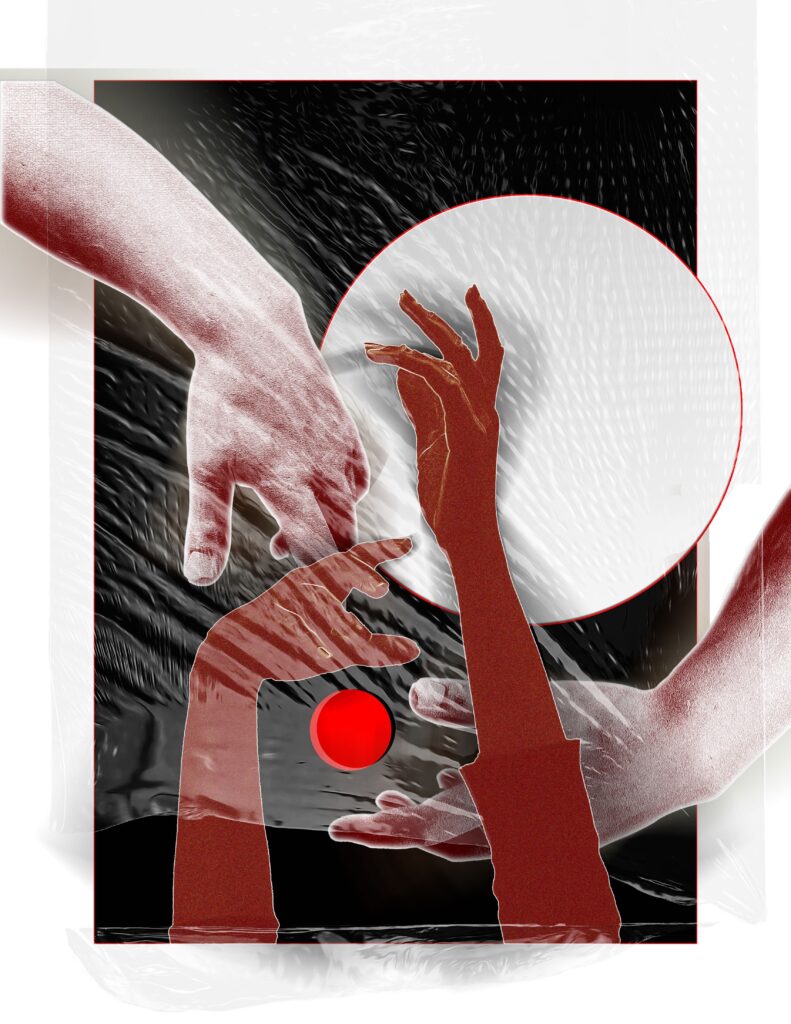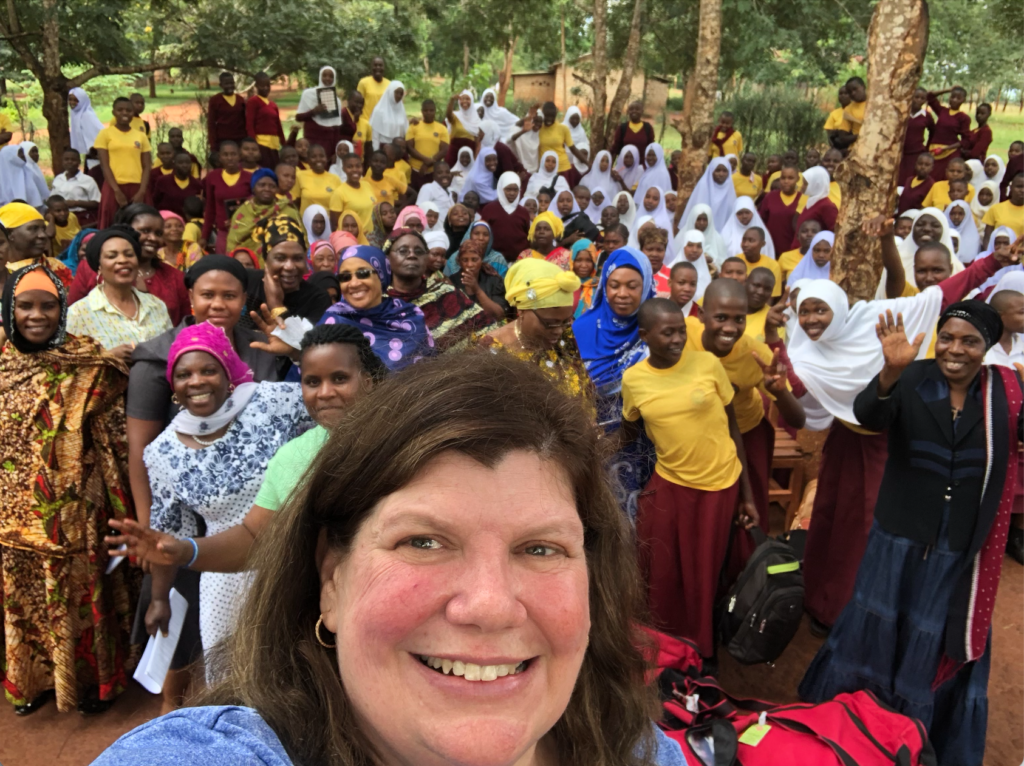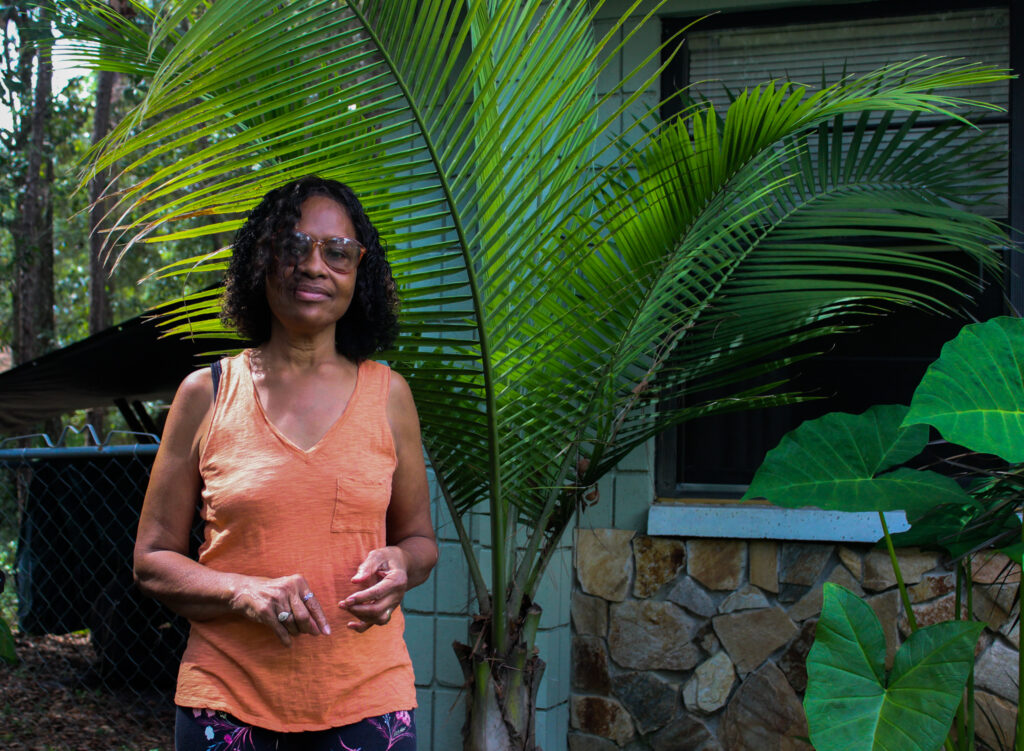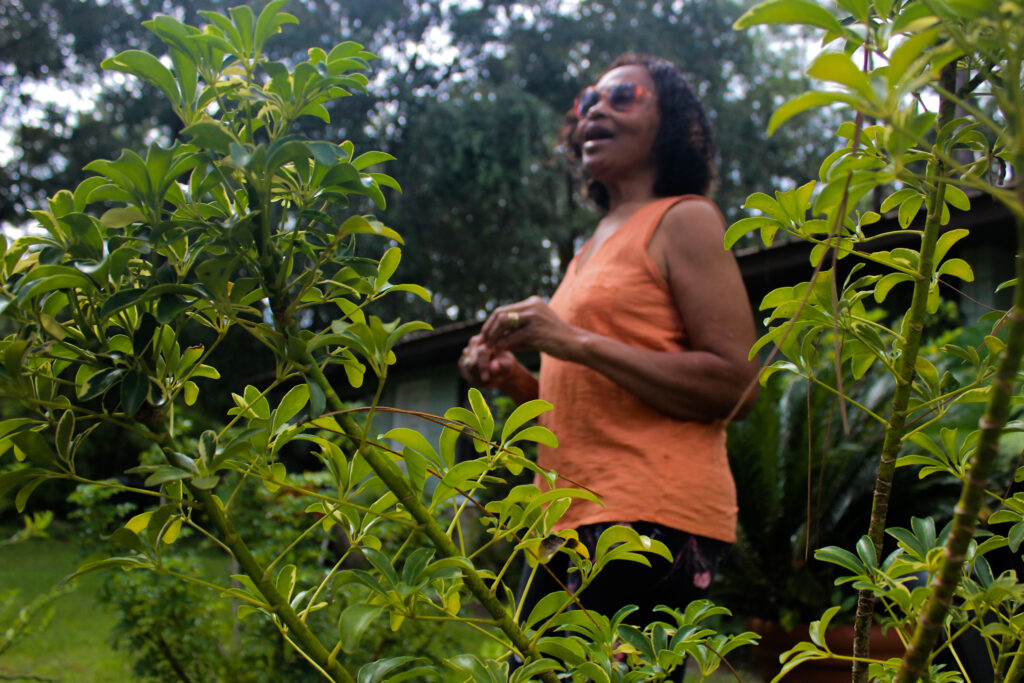Survivors of the AIDS epidemic lived through stigma and fear. They are experiencing it again with COVID-19.

October 28, 2021 | Story by Chloe Greenberg | Illustration by Apoorva Thapa | Photos by Sarah Breske
It was not the prolonged headache, coughing or fatigue that scared Ken Bargar when he contracted COVID-19 last winter. It was the memories that haunted him.
He studied the oximeter that grasped his index finger two, three, four times a day. He knew if his oxygen levels dropped any further, he’d be on his way to the hospital. It was a fear he carried in the past.
“It was a flashback: I’m going to the hospital. I’m going to die,” he thought.
A week before Christmas in 1997, Bargar, now 58, had fallen sick and watched his weight plummet by about 80 pounds. His mouth was consumed by fungus, a case of oral thrush marked a deteriorating immune system. When the diagnosis came, doctors told him he had six months to live.
He was going to be one more gay man who died of AIDS.
Even before his own diagnosis, Bargar had watched his loved ones die. He suffered one, two, sometimes three losses a month.
At the height of the AIDS epidemic in the United States, gay men like Bargar often learned to live in a steady state of fear. At the time, he was living in Lakeland, where he and his friends weaved together a circle of support; planning and paying for funerals of friends came as regularly as celebrating birthdays. Watching lives end became a prophetic reality.
It was not uncommon for AIDS- and HIV-related deaths to be handled by friends rather than families or parents. The epidemic catalyzed not only a fear of contraction and death but a polarizing stigma around sexuality. Bargar typically organized funerals for friends whose parents had disowned them or whose families had neglected them altogether — killed by the same virus that severed them from their homes.
Nearly 40 years following the rupture of the AIDS epidemic, Bargar remains chilled by his dance with death, as the coronavirus pandemic has subjected him to reliving a past horror.
“There was a lot of confusion, a lot of stigma attached to it,” Bargar says. “It’s kind of history repeating itself.”
For him and other HIV and AIDS survivors, COVID-19 has been more than a mere new abnormal. It has been the reopening of a door leading to a world similar to the one they once faced privately — hidden behind masked information and with government officials’ backs turned.
While the stigma around HIV has historically been more intense than that of COVID-19, the two share a paralleled polarization, says University of Florida professor of epidemiology Robert Cook. He attributes this to a deep-seated fear of disease and contraction that society has historically and unwaveringly gripped onto.
“There was a lot of blame,” he says. “There still is a lot of blame.”

Marvene Edwards thought her life was over when she was assaulted and diagnosed with HIV three decades ago. But she’s since broken through the stigma and found hope. Edwards is quick to charm with a joke — and never afraid to be the first to laugh at herself. (Sarah Breske/Atrium)
Gay Koehler-Sides, the HIV/AIDS program coordinator at the Alachua County Health Department, draws a similar comparison between HIV and COVID-19. Both viruses can spread asymptomatically and lead to unknowing and unintentional transmission.
Koehler-Sides says people often shy away from being tested for HIV by the fear and stigma surrounding the virus.
“Even though we’re here in 2021, you would think that we wouldn’t still see that, but unfortunately we do,” she says.
The ‘80s and early ‘90s saw the virus ravage communities and claim lives. But the ongoing stigma around HIV became a hurdle to securing federal funding needed for medical research to find treatment options and maybe even a cure.
“Back then, it was just the gay man’s disease, or you had to be a bad person to get it, or people got what they deserved,” Bargar says.
As anti-LGBTQ+ sentiment and sexuality shame pervaded the public sphere and threatened progress in HIV and AIDS treatments, the virus raged on — blind to the societally constructed stereotypes and expectations to which it was linked.
At the same time Bargar was beginning to face his diagnosis and brace for the unknown with his peers, his friend Cathy Robinson-Pickett, long acquainted with the proximity of death, set out to ease the fear of others.
Robinson-Pickett was 18 when she contracted HIV. A college student working at a corner store in Tallahassee in 1984, she wasn’t the typically pictured victim of the virus. But when three men robbed the store and violently sexually assaulted her, she was unknowingly left to live with a disease that would end up threatening her life.
“Well, if we sit here, we’re going to die. But, you know, I want to create something that leaves something of me behind.”
– Cathy Robinson-Pickett
HIV was never her first concern, she remembers. The initial trauma and fear of pregnancy was what she felt the strongest. It wasn’t until years later, in 1991, that her diagnosis took a stranglehold of her.
With an 11-month-old daughter and pregnant with her son, Robinson-Pickett and her then-husband (and college boyfriend) tested positive for HIV when applying for life insurance. She found out that one of her Tallahassee corner store assaulters had died in prison with an HIV-positive status years before.
“The law in Florida at the time was that no matter what the crime — rape, trauma, sexual assault — the victim of the crime wasn’t notified of the attacker’s status unless the attacker gave their permission,” she says.
Left blindsided and fearing for her death, Robinson-Pickett, now 56, was then introduced to the virus that would determine her life in more ways than one. Both of her children received negative HIV tests, but her marriage ended, and her life was about to change once more.
In the years to come, she would meet Steve Pickett – an HIV-awareness advocate and gay man 12 years her senior.
Much to her surprise, they fell in love and got married. Life isn’t always a straight shot, she says.
The two came together, intertwining separate lives that had simultaneously revolved around the same fatal disease. But when Robinson-Pickett was diagnosed with breast cancer in 1999, she inched toward death once more.
With her preexisting HIV status and subsequently impaired immune system, Robinson-Pickett’s doctor one day nudged the couple to start considering a “transition plan”: a gentler way of introducing the idea of death. Though not any less world-shattering, her cancer diagnosis was met with a jaded understanding of the potential end of the road she faced.
“It really looked like the end was here.”
The couple drove home that day, northbound on Interstate 95 from Jackson Memorial Hospital in Miami, in silence. They muddled over the curse that a doctor and some malignant cells had just cast over them.
Without a second to think and with a blur of cars racing past them, Robinson-Pickett watched as her husband suddenly swerved the car through lanes of traffic and pulled over.
“What do you want to do with the rest of your life?” he asked her.
“Well, if we sit here, we’re going to die,” she replied. “But, you know, I want to create something that leaves something of me behind.”
From this conversation, the two launched Friends Together, an HIV and AIDS support and education nonprofit organization based out of Lakeland. They reeled in about 20 friends — one of whom was Ken Bargar. Soon after, they had assembled a band of passionate survivors and allies looking to impart knowledge, resources and, importantly, hope.

Robinson-Pickett poses with community members in Tanzania, one county historically hit hardest by high HIV and AIDS rates. Friends Together has a longstanding relationship with the region, where they built a clinic for women and continuously run women’s health education programs. (Photo courtesy of Robinson-Pickett)
Now, with her 22-year-old grassroots startup-turned-international-HIV-support-network, Robinson-Pickett’s legacy is laid out before her. But when the COVID-19 pandemic struck, things seemed to halt once again.
Her longtime relationship with HIV, cancer, Type 1 diabetes, suppressed immunity and fervor for public advocacy crashed together in an emotional surge when the public health crisis erupted in 2020. The polarization she saw online and from those near to her transported her back to the early days of her HIV diagnosis, when she battled the persecution and stigma of a positive status, even as she displayed no outwardly physical signs of the disease.
“Even though it was different, it was so much the same emotion — the anger that I felt.”
She began staying at home out of concern for her health. She ordered groceries to her door and taught her students from behind a computer screen, miles away. She grew angry and began to drown in abject sadness.
Once again, her health battles took center stage as the pandemic took hold. And she worried that people were returning to normalcy too fast, that they had grown indifferent to the dangers of the virus.
The health battles put in front of her almost her whole life come back to her every day now, as she risks all that she has prevailed against for infrequent grocery store runs and family gatherings. Having come so close to death so many times before, she fears a normalization of and an indifference toward COVID-19, which she sees in many of those around her.
Meanwhile, across the state, sitting at the crossroads of the battle against AIDS stigma, gender and race, is survivor Marvene Edwards.
In her Gainesville home, Edwards, 65 years old and living with an HIV-positive status for more than 30 years, has been spending her days similarly inside and out of reach of the health risks that roam beyond the safety of her apartment walls.

Edwards stands with her “Charlie Brown” tree, which she named after nursing it to health early on in her diagnosis. Years ago, she planted in the young tree’s soil a letter reflecting on her journey, hoping to release herself of fear and hurt. (Sarah Breske/Atrium)
Tending to her plants and steadily humming to the music that plays on her TV at all times, Edwards has accepted a comfort in staying home to avoid possible COVID-19 contraction in her immunocompromised state. But what remains within her is a disappointment – one she tries to combat by spreading positivity.
Edwards is well accustomed to the stigma and prejudice spurred by the early days of the AIDS epidemic. As a Black woman, she deals with her diagnosis and seemingly never-ending social
persecution. She’s watched the COVID-19 pandemic unfold from behind her home’s walls, and
memories of that persecution flood back to her
“This particular virus does not discriminate,” she says. “This is something that is attacking society, period.”
Edwards was first diagnosed with HIV in 1987. She was 31 and a mother of four, walking home from a nightclub in the unincorporated town of Princeton in Miami-Dade County. The three men who beat, shot and sexually assaulted her left her unresponsive in their trail.
It wasn’t until a woman walking her dog reported the body, the paramedics arrived and the body bag was unzipped that they realized Edwards was alive — with whatever little life she had left. Transported to the hospital and saved within a hair from fatality, Edwards was granted a second go at life. This time, she had much more at stake. She would have to survive with HIV.
Edwards’ initial diagnosis led her to a dark place. It would have steered her to her grave had she not stumbled into a support network. Her local HIV counselors, doctors and therapists helped Edwards tear away from the part of her that decided she had no life left to live when they opened up that body bag.
Since then, and since her full-blown AIDS diagnosis in 2003, Edwards’ life’s work has become breaking the stigma of HIV and being a voice for those who can’t use their own.
“Instead of being on a pity party, I prefer being in that army, being one of the soldiers…fighting for our voices,” she says.


Edwards’ plant collection today punctuates a lifelong affinity for the natural world. Her plants are her babies, many of which she’s nursed from near death. “I don’t mind my hands getting dirty,” she says. (Sarah Breske/Atrium)
One of Edward’s most pressing concerns is the lack of attention HIV and AIDS efforts often receive in the public eye. While she commends advancements in COVID-19 prevention, she wonders what needs to be done for widespread effort into HIV progress and reversing disparaging perceptions.
“A person is not ashamed of corona[virus], but HIV has such a stigma that comes along with it,” she says. “They don’t get to know the person; all they see is HIV.”
Edwards’ resurfacing memories of the AIDS scare largely revolve around isolation.
“When I first contracted it, you isolated, you stayed off by yourself, you didn’t want to be around people,” she says. “Now with corona[virus], we’re doing this for our health.”
Edwards now dedicates her time to local HIV support and education groups, where she uses her story to inform others and spread awareness. She is president of Peers Empowering Peers, a Gainesville HIV-positive support group. She leads the women’s group Let’s Talk About It and participates in a number of other groups and organizations.
One is the Gainesville Area AIDS Project, or GAAP.
Gainesville Area AIDS Project is a nonprofit organization formed in 1995 by five mothers whose sons had HIV, program director Ty Harrison says. From its inception, GAAP sought to fill a hole in the community where support and resources for HIV-positive individuals were missing.
“The idea was just to provide a support setting for people who have it [HIV] or people who are affected by it to come and talk,” he says.
At its start, GAAP’s focus demographic was younger generations who were being heavily affected by HIV and were often left without work or government assistance. The AIDS epidemic had only just started seeping its way into the public eye but was still largely outside of public concern. With so much uncertainty about the virus spreading, stigma raged on, and those affected were left to navigate life or death on their own.
“I saw everybody I knew die. It was death, death, death, death, everywhere you turned.”
– Ty Harrison
Harrison, 50, started volunteering with GAAP in 2006. Now, as program director, he oversees supplies distribution as well as client and executive matters.
Since the start of the COVID-19 pandemic, he’s seen the resurfaced fears in those living with HIV and AIDS as uncertainty reigns on.
“There were just no answers about how it would affect people like us; if it was going to affect us differently, quicker, easier,” he says.
Unanswered questions and unaddressed concerns were nothing new to the community, though.
Harrison remembered going to friends’ houses for dinner in the late 1980s and seeing walls lined with pictures of friends and family members who had died of AIDS.
“I saw everybody I knew die,” he says. “It was death, death, death, death, everywhere you turned.”
Today, Harrison sees his clients and surrounding community face the emotional and psychological strain that comes along with isolation, whether it be for the safety of the whole or the preservation of the self. Just as much of the HIV- and AIDS-positive community looks to the past for guidance and remembrance to navigate resurfaced emotions and confusion, many also look to the future.
As the COVID-19 pandemic remains ever-evolving and continuously ignites fear, HIV and AIDS survivors share a common sentiment: Education and awareness are priceless.
AIDS survivor Bargar trudges on with his volunteer work as a health education speaker, as he hopes to instill in younger generations the information and resources necessary for a safe and prolonged life. With his experiences contracting both COVID-19 and AIDS, Bargar’s prioritization of educating younger people about sexual health has never before been more prominent or needed.
Bargar, and those who share his diagnosis, can only continue to use what he knows in the face of COVID-19. He tells people they’re not as invulnerable as they like to believe in times of severe health crises. Years ago, he begged friends to wear condoms. Today, he’s asking everyone to wear a mask.